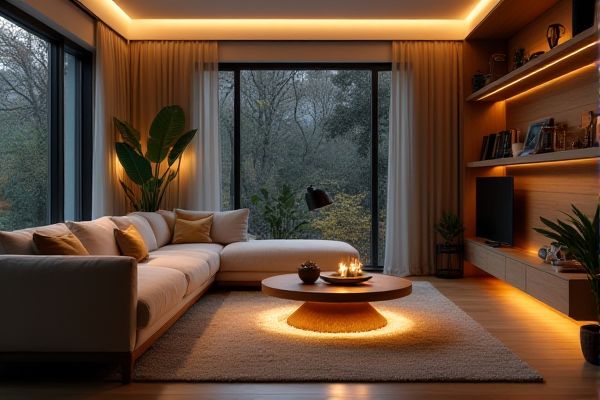
Automatic lighting systems adjust brightness and color based on ambient conditions, enhancing energy efficiency and convenience, while manual lighting requires direct user control to operate and customize settings. Discover how choosing between automatic and manual lighting can impact your home's atmosphere and energy consumption in the rest of this article.
Table of Comparison
| Feature | Automatic Lighting | Manual Lighting |
|---|---|---|
| Control Method | Sensor-based or timer-controlled | User-operated switches or dimmers |
| Energy Efficiency | High - lights activate only when needed | Variable - depends on user behavior |
| Convenience | Hands-free, automatic adjustment | Requires manual operation |
| Installation Cost | Higher due to sensors and automation systems | Lower, traditional wiring and switches |
| Maintenance | Moderate - sensor calibration and system checks | Low - simple hardware maintenance |
| Customization | Limited to preset settings or app control | Full user control over lighting levels |
| Reliability | Dependent on sensor accuracy and power supply | Highly reliable; straightforward operation |
| Use Cases | Public spaces, offices, automated homes | Residential rooms, manual workspace lighting |
Introduction to Automatic vs Manual Lighting
Automatic lighting systems use sensors and timers to adjust illumination based on occupancy and natural light levels, providing energy efficiency and convenience. Manual lighting requires user intervention to turn lights on or off, offering direct control but potentially leading to higher energy consumption. The choice between these systems impacts energy savings, user comfort, and operational costs in residential and commercial environments.
Key Differences Between Automatic and Manual Lighting
Automatic lighting systems use sensors and timers to adjust brightness based on environmental conditions, providing energy efficiency and convenience. Manual lighting requires direct user control to turn lights on or off, offering personalized adjustments but potentially increasing energy consumption. Choosing automatic lighting can enhance your home's smart features and reduce electricity bills through optimized usage.
Benefits of Automatic Lighting Systems
Automatic lighting systems enhance energy efficiency by adjusting illumination based on occupancy and natural light levels, significantly reducing electricity consumption. These systems improve convenience and safety through hands-free operation and timely activation, minimizing dark areas and enhancing security. Integration with smart home technology allows for customizable settings and remote control, optimizing lighting usage tailored to individual preferences and schedules.
Advantages of Manual Lighting Control
Manual lighting control offers precise customization of brightness and ambiance tailored to Your immediate needs, enhancing comfort and atmosphere. It provides direct user feedback and intuitive adjustments without reliance on technology, reducing potential errors or malfunctions. Additionally, manual systems often involve lower installation and maintenance costs compared to automatic lighting solutions.
Energy Efficiency Comparison
Automatic lighting systems optimize energy use by adjusting brightness based on occupancy and natural light, significantly reducing unnecessary power consumption compared to manual lighting. Manual lighting relies on user intervention, often leading to lights being left on longer than needed, which increases energy waste. Your energy bills can be substantially lowered by choosing automatic lighting solutions that enhance efficiency through smart sensors and timed controls.
Cost Implications and Savings
Automatic lighting systems typically involve higher upfront installation costs due to sensors and control technology but offer significant energy savings by reducing electricity consumption through motion detection and daylight adjustment. Manual lighting incurs lower initial expenses but often leads to increased utility bills because lights may be left on unnecessarily. Over time, the energy efficiency of automatic lighting results in reduced operational costs, making it a cost-effective solution despite the initial investment.
User Convenience and Accessibility
Automatic lighting enhances user convenience by eliminating the need to physically switch lights on or off, making spaces more accessible for individuals with mobility impairments or busy hands. Manual lighting requires direct user interaction, which can be less practical in dark or obstructed environments. Your experience improves significantly with automatic lighting through hands-free operation and sensor-based adjustments that respond to movement or ambient light levels.
Installation and Maintenance Considerations
Automatic lighting systems require professional installation involving sensors, timers, and wiring integration, which can increase initial setup costs compared to manual lighting that only needs basic switch installation. Maintenance for automatic lighting includes regular sensor calibration and occasional software updates to ensure optimal performance, while manual lighting typically involves simpler tasks like bulb replacement and switch repair. Choosing automatic lighting improves energy efficiency and convenience but demands higher upfront technical expertise and ongoing upkeep.
Ideal Applications for Each Lighting Type
Automatic lighting systems are ideal for environments requiring energy efficiency and convenience, such as office buildings, streets, and smart homes where sensors adjust lighting based on occupancy and natural light levels. Manual lighting is best suited for settings that need precise control, like art galleries, photography studios, and theaters, where users must customize light intensity and direction. Choosing between automatic and manual lighting depends largely on the balance between automation benefits and the need for user-driven adjustments in specific applications.
Choosing the Right Lighting Solution
Automatic lighting systems offer energy efficiency and convenience through motion sensors and timers, reducing electricity consumption and maintenance costs. Manual lighting provides greater control and customization, ideal for specific tasks or ambiance settings where precise adjustment is necessary. You should assess your space's usage patterns and energy goals to determine whether automated technology or manual controls best complement your lighting needs.
 homyna.com
homyna.com